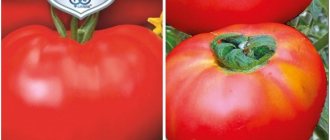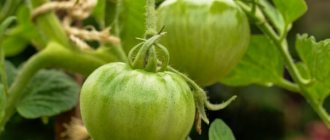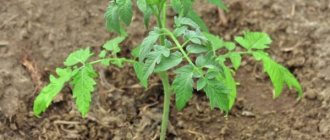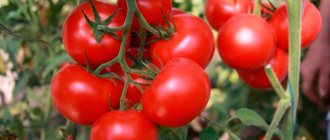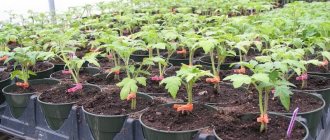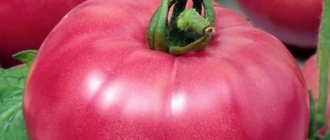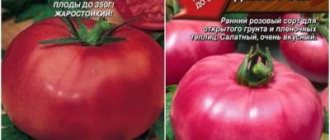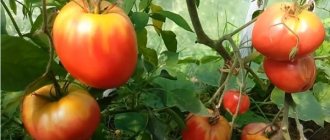Tomato “Crimson Giant”: description of the variety
| Variety name | Crimson Giant |
| general description | An early-ripening, determinate variety of tomatoes that does not require growth regulation |
| Originator | Russia |
| Ripening period | 90-105 days |
| Form | Rounded |
| Color | Crimson |
| Average weight of tomatoes | 200-400 grams |
| Application | Universal |
| Productivity of the variety | 18 kg per sq. meters |
| Features of cultivation | Standard agricultural technology |
| Disease resistance | Resistant to major tomato diseases |
The tomato has a first-generation hybrid of the same name, “Crimson Giant F1,” which differs somewhat in qualitative characteristics.
The varieties are slightly inferior to hybrid plants in some properties (size, taste, resistance to weather conditions, resistance to diseases, etc.). But hybrids require more attention and have a clear disadvantage - it is impossible to get a good harvest from their seeds next year, and unforeseen negative results are possible.
Tomatoes "Crimson Giant" are a determinate variety that does not require growth regulation - no need to pinch out growing points. The type of bush is not standard. Read about indeterminate varieties here.
Standard varieties of tomatoes are small in size, compact in shape, and do not require pinching. The root system is poorly developed. The stem of the plant is strong, persistent, well-leafed, with a height of 50 cm to 100 cm, on average about 70 cm. The brushes are fan-type, there can be up to 12 of them on a bush.
The rhizome is well developed, grows wildly in all directions without deepening. The leaves are dark green, large in size, and have a typical tomato shape. The structure is slightly wrinkled, without pubescence. The inflorescence is simple, intermediate type. The first inflorescence is formed above the 5th - 6th leaf, then they come with an interval of 2 leaves. There are 6 - 8 flowers, you should not pick them off. Pedicel with articulation. Large fruits hold up well. According to the degree of ripening, “Crimson Giant” is an early ripening variety. The fruits on the plant do not crack. Has few seeds.
The harvest can be harvested 90 days after the appearance of the main shoots. It has average resistance to common diseases: Alternaria, Fusarium, Verticillium. There is no time to get sick with late blight, since the harvest period begins before the temperature changes begin. Growing is permissible in open ground with temporary shelter and in greenhouses. The “Crimson Giant” tomato variety has excellent yields - from 6 kg per plant, from 18 kg per 1 sq.m.
As for the yield of other varieties, you will find this information in the table:
| Variety name | Productivity |
| Crimson Giant | 18 kg per square meter |
| Banana red | 3 kg per square meter |
| Nastenka | 10-12 kg per square meter |
| Olya la | 20-22 kg per square meter |
| Dubrava | 2 kg per bush |
| Countryman | 18 kg per square meter |
| Golden Jubilee | 15-20 kg per square meter |
| Pink spam | 20-25 kg per square meter |
| Diva | 8 kg per bush |
| Yamal | 9-17 kg per square meter |
| Golden heart | 7 kg per square meter |
Read on our website: How to prepare soil in a greenhouse in spring? What soil is suitable for growing seedlings and adult tomatoes in greenhouses? What types of soil for tomatoes are there? And also, the use of growth stimulants, fungicides and insecticides when growing nightshades.
Reviews from gardeners
Farmers who have planted the Raspberry Giant variety more than once speak extremely positively about it.
Natalya Tsvetkova, 40 years old, Novorossiysk
The Raspberry Giant variety is best suited for canned lecho and tomato snacks - I’ve been growing it for 3 years now and it has never failed. The seeds germinate well and produce full-fledged healthy seedlings that take root well in open ground. Throughout the summer, I only spray the beds with potassium permanganate and soap solution a couple of times.
Svetlana Vasilyeva, 57 years old, Ivanovka
I have been planting Crimson Giant every summer for 4 years now. This is one of the best varieties for summer salads and tomato appetizers. My seedlings have never gotten sick, and I do not use any additional feeding except a solution of cow manure. The productivity is high, the tomatoes are large - one fruit weighs about 300-400 grams. I cut them into salads in early fall and add them to appetizers.
Characteristics
The shape is round, flattened at the top and bottom, with medium ribbing. The fruits have a marketable appearance and grow to approximately the same size. The dimensions are large - from 10 cm in diameter, weight about 200-400 g, sometimes more.
And in the table below you will find such characteristics as the weight of fruits of other tomato varieties:
| Variety name | Fruit weight (grams) |
| Crimson Giant | 200-400 |
| Kate | 120-130 |
| Crystal | 30-140 |
| Fatima | 300-400 |
| Explosion | 120-260 |
| Raspberry ringing | 150 |
| The Golden Fleece | 85-100 |
| Shuttle | 50-60 |
| Bella Rosa | 180-220 |
| Mazarin | 300-600 |
| Dad | 250-400 |
The skin is dense, thin, smooth, shiny. The color of unripe fruits is pale green with darkening at the stalk; ripe tomatoes are pink or crimson in color. The pulp is medium density, fleshy, juicy. The fruits contain few seeds; there are 4 or more chambers for them.
Important! The seeds are small in size. For most large-fruited varieties, this is the norm!
The amount of dry matter is below average. The harvested crop is stored for a satisfactory long time. Tomatoes are stored in a dark, dry place at room temperature. Temperature changes are not allowed. Transportation is tolerated well, even over long distances.
Reviews about the taste of “Raspberry Giant” are only positive. A sweet tomato with a slight sourness is suitable for dietary and baby food; tomatoes do not cause allergies. There are more useful substances in pink and dark pink tomatoes than in red ones. They are consumed fresh, added to salads and soups, frozen, and stewed. After treatment with heat or cold, tomatoes do not lose their vitamins.
Tomatoes of the “Raspberry Giant” variety are not suitable for whole-fruit canning due to their large size; when crushed in various canned salads and preparations, they are ideal and add a new taste to the dish. Ideal for the production of tomato paste, ketchups, sauces and juices.
Advantages and disadvantages of the variety
Like all tomatoes, the Raspberry Giant has a number of advantages and disadvantages. Obvious advantages:
- early ripeness;
- large fruit size;
- preservation of presentation;
- excellent harvest;
- resistance to diseases and pests.
Every gardener who has planted and cultivated the Raspberry Giant notes that most of the beneficial properties and high taste are preserved during heat treatment, giving the most positive reviews about the variety.
The only fact that in a certain way can play the role of a disadvantage and spoil the description of a tomato is the impossibility of using this tomato in canning in its entirety. Isolated cases of disease may occur, but this is a fairly rare occurrence. In general, the Raspberry Giant is characterized extremely positively and has many excellent reviews from gardeners.
Growing
Seeds for seedlings must be disinfected in a weak solution of potassium permanganate. After 2 hours, rinse with warm running water. The soil chosen is loamy or sandy loam, it must be well enriched with air, fertile with a low level of acidity and also disinfected. It is recommended to treat the seeds with various growth stimulants.
At the end of March or beginning of April, the seeds are sown in a common wide container to a depth of about 2 cm, the distance between the seeds should be at least 2 cm. The soil should be warmed to at least 25 degrees.
The soil should be slightly compacted, watered with warm water and covered with material that does not allow evaporation. Polyethylene, plastic or thin glass will do. The moisture generated in the container has a beneficial effect on germination. The temperature must be at least 25 degrees.
After the majority of shoots have appeared, remove the covering. Place the seedlings in a bright place. Water as needed. When 2 well-developed sheets are formed, pick them into separate 300 ml containers.
REFERENCE. Picking is necessary for the development of the individual root system and plants as a whole.
You can fertilize with mineral fertilizers. A week before planting in a permanent place, the seedlings are hardened - they open the windows for several hours or take them out onto the balcony.
At the end of June, the seedlings are completely ready for transplanting; the color of the stems at the roots acquires a bluish tint. Plant seedlings at a distance of 50 cm from each other. Mullein or other fertilizer should be placed in the holes. It is better to add fertilizers containing phosphorus; tomatoes love it.
Water as needed, abundantly, at the root. Loosening and weeding as necessary. Feeding is carried out several times per season.
Pruning requires partial, a bush of 2 stems is formed, the side shoots are removed. Tying in the presence of large fruits to vertical trellises. Mulching will help control weeds.
For growing Raspberry Giant tomatoes in open ground, the southern and southwestern regions of the Russian Federation and those adjacent to the southern border of the country will be most favorable. In greenhouse conditions it is possible to grow throughout the Russian Federation.
Read more about how and what to fertilize tomatoes:
- Organic and mineral, ready-made complexes, TOP best.
- For seedlings, when picking, foliar.
- Yeast, iodine, ash, hydrogen peroxide, ammonia, boric acid.
Transplanting seedlings and subsequent care
The seedlings are transplanted into a greenhouse or open ground 2 months after the first germination of the seeds, but 2 weeks before transplanting the seedlings are hardened off - for this purpose they are taken outside or into the greenhouse during the daytime. Final planting occurs in the second half of April (for greenhouses) or in May-June (for vegetable gardens).
The transplant is carried out as follows:
- Debris and weed roots are removed from the pre-dug area.
- Water the soil with boiling water and manganese solution.
- Holes are dug (up to 40 cm deep, 50 cm between holes).
- A small amount of sand and fertilizer (humus and superphosphate) are placed at the bottom of the hole.
- The bed is moistened.
- Plant seedlings 2 bushes per hole.
After planting, the entire bed is sprinkled with wood ash - this will repel parasites. Further care is extremely simple:
- Plants are tied up as soon as the stem begins to sag;
- Watered.
- The beds are being loosened.
- Remove weeds.
- Crowns are formed by removing excess growth.
See also Tomato Novichok Pink and De Luxe: description, yield and characteristics of the variety
With properly prepared soil and quality care, farmers can harvest the first ripened tomatoes within 3 months after planting.
Watering and fertilizing
The irrigation system is the same as for other tomato varieties - seedlings need to be irrigated only when the soil has dried out and started to crack. To do this, you need to use warm water, preferably pre-settled.
The first feeding is given to the seedlings 2 weeks after planting - they should take root properly. The first fertilizers should be mineral - they are dissolved in water for irrigation. Nitrogen complexes are occasionally added - this will help the bushes grow a strong crown.
The second feeding occurs 14 days after the first, but organic fertilizers are used for it: a solution of bird or cow manure with water. After this, the seedlings can be fertilized every 3 weeks, trying to alternate the type of fertilizer.
Expert opinion
Stanislav Pavlovich
Gardener with 17 years of experience and our expert
Ask a Question
Important! A day after watering, the soil must be loosened!
Garter and shaping
To form slender tomato bushes, they must be tied to wooden pegs as soon as the stem grows so large that it begins to bend. When gartering, it is better to use fabric treated with potassium permanganate; you cannot use wire or thread.
All lower leaves are torn off to protect the plant from parasites. Of the 2 planted stems, leave the main one and one stepson in the upper axil. Excess stepsons that have reached 10 cm are removed regularly in the evening and in cool weather.
Protection from diseases and insects
Raspberry Giant tomatoes are resistant to parasites and diseases, so they practically do not need to be sprayed with chemicals. However, seedlings are occasionally affected by the Colorado potato beetle and late blight. The best protection against possible damage to tomatoes is to treat their seeds and soil before planting.
Preventive treatment of plants consists of weekly spraying with a weak solution of manganese. If parasites have already infected the plants, then they need to be treated with herbicides that do not accumulate in the fruits. Insecticides can be applied to the soil in the fall to remove all fungal larvae and spores.
Diseases and pests
As mentioned above, tomatoes are resistant to most diseases. However, plantings may be threatened by pests - Colorado potato beetles, thrips, aphids, and spider mites. Preventive actions (spraying) with special preparations of general action against pests and diseases are necessary.
Advantages and disadvantages
Let us highlight the main pros and cons of the “Raspberry Giant” variety of tomatoes. This will help you understand whether you need these tomatoes in your garden or not.
Strengths:
- large fruits and good yield;
- universal table purpose;
- possibility of commercial use;
- long storage;
- relative resistance to diseases.
Weak sides:
- a number of diseases and insects affect the crop;
- may not be grown outdoors everywhere;
- requires attention and time for agricultural technology.
Agree, there are still more advantages. Of course, this tomato will not grow on its own; you will have to take care of it, but the result is still worth it.
Features of care
As the bush grows, it is necessary to install support not only for the main stem, but also for the branches. It is best to form the plant into two stems, which is necessary to increase the yield.
It is recommended to water the beds as the top layer of soil dries. Weeds should not be allowed to grow, so weed regularly. After each watering, loosen the soil so that oxygen and nutrients reach the roots without obstacles.
Two weeks after transplantation, the first mineral fertilizing is carried out; after another two weeks, organic components must be added. It is also useful to carry out foliar spraying of bushes.
Tomatoes love infusions based on wood ash and herbs. You should be careful when using fertilizers containing nitrogen. The component is added in accordance with the recommended dosages and not too often. Nitrogen is necessary during the initial development of a young plant, when the green mass needs to gain strength and growth. During the second growing season, tomatoes need potassium and phosphorus.
See also
Description of the Korean long-fruited tomato variety and cultivation features
Read
Features of agricultural technology and reviews from vegetable growers
Whether you are an experienced farmer or a novice gardener, it would be a good idea to listen to the recommendations of the variety breeders.
- Seeds for seedlings must be planted taking into account the climatic characteristics of the region: 40 days before transferring to a permanent bed in warm areas, and from 40 to 60 days in those where there is a high probability of spring frosts.
- Planting pattern: 60x50 cm, i.e. per 1 sq. m. no more than 3-4 plants should be placed.
- It is better to form in 1 stem, but 2 are also allowed, without loss of yield and reduction in the weight of tomatoes.
And here is how avid tomato growers speak about tomatoes.
Alexey from the Leningrad region writes: “I like it when the whole family can have lunch with one tomato. The largest of the planted Giants was 650 g. The rest showed an average weight of 200 to 500 g. The taste is 100% satisfactory, so I have been growing it for several years. I noticed that it is best to form this tomato into one trunk - the yield will be higher.”
Svetlana from the Perm region shares: “I chose a tomato based on the photo, and did not regret the decision. I grew a couple of bushes in a greenhouse, the rest in an open garden bed. The street tomatoes were the first to ripen. Maybe because the greenhouses dropped their flowers from the heat. I watered it once a week, fed it with organic matter (no chemicals) and mineral fertilizers.”
Summing up, we can safely say that growing delicious tomatoes on your own plot is not difficult, the main thing is to choose the right variety.
Origin of the variety
The selection of “Crimson Giant” tomatoes was carried out by Anatoly Nikitovich Lukyanenko and his team of professionals. The patent belongs to . The variety was officially registered in 2007. Tomato bushes are of medium height, and the fruits ripen early. Despite the fact that breeders indicated a maximum height of 0.9 m, in practice the bushes rise much higher. Sometimes it is necessary to tie up the bushes to maintain maximum yield, as they become spreading.
The “Crimson Giant” fruits can grow not only large, but also medium in size. The lower the ovary, the larger the fruit. The weight of one tomato can reach 0.4-0.5 kg, but often their weight does not exceed 0.3 kg. The ripeness of the fruit is indicated by the tomatoes acquiring a bright crimson hue. Tomatoes do not always grow round and sometimes acquire an irregular shape, but they always reach large sizes. It is advisable to use them immediately after removal, since they cannot be stored for a long time and become deformed during transportation.
